|
Common Snapping Turtle, Chelydra serpentina
|
| Snapping turtles are the largest of the freshwater turtles inhabiting the United States. Their general form is well known. The dull, rough carapace or upper shell, with its heavy keels and marginal serrations, the proportionately huge and sinister head, and the long, fleshy tail, with its alligator-like crest, combine to make these turtles unique. The plastron, or flat belly portion of the shell, is insignificantly small and narrow and affords comparatively no protection, but these big turtles do not seek to withdraw the head and limbs like their smaller and weaker cousins like box turtles. |
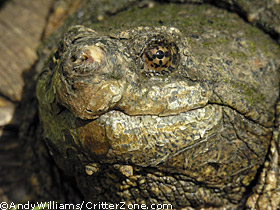 snapping turtle closeup, Chelydra serpentina
snapping turtle closeup, Chelydra serpentina
|
| Snapping turtles are bold and aggressive fighters and their massive, sharp-edged jaws cause them to be the terror of most of the aquatic and semi-aquatic creatures. The common snapping turtle, Chelydra serpentina, can be larger than any other species of North American turtle, except the alligator snapping turtle, Marcochelys lacertina. Adult specimens of the alligator snapper can reach a weight of 130 to 140 pounds! Large specimens of the common snapper can weigh forty pounds and such would have a carapace, or shell, about fourteen inches long. Both are a fresh water inhabitants, and the common turtle has a range from Southern Canada and the United States generally east of the Rocky Mountains; southward through Mexico to Ecuador. |
| The turtle's shell is very sharply serrated in the rear. There are three blunt, broken keels, rising as tubercles at the rear margins of the shields through which they pass. The shell of old individuals is quite smooth. With young specimens there are radiating lines or ridges from the higher portions of the keels. Very young specimens are exceedingly rough. The plastron is small and narrow, exposing a great amount of the turtle's fleshy parts. The under-surface of the tail is covered with large shields. As with all of the very aquatic turtles, the feet are broad and extensively webbed. |
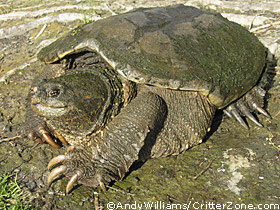 common snapping turtle, Chelydra serpentina
common snapping turtle, Chelydra serpentina
|
| Both front and rear pairs are provided with large and coarse nails. Most characteristic about the snapping turtles is it's huge and powerful head. The upper and lower mandibles terminate in strong hooks. Though the eyes are comparatively small, they have very good vision. The head and tail cannot be completely withdrawn into the shell. |
| The snapping turtle's appearance includes a carapace in dull olive or dark brown, with little or no markings, and a dull yellow plastron. The upper portion of the head is very dark as is the upper surface of the legs and tail which are yellowish underneath. |
| Sinister in appearance and equally vicious as its looks imply, the snapping turtle is one of the most familiar of the North American reptiles. It inhabits slow running and muddy, rivers, streams, ponds and marshes. Very old specimens are sometimes so bloated and overburdened with fat that their fleshy parts protrude beyond the margin of the shell and so hinder the progress of the limbs that the reptile is almost helpless when removed from the water. Specimens in this condition are said to be excellent as food. In early 20th century America, large numbers of snapping turtles were sold in the food markets as table meat. |
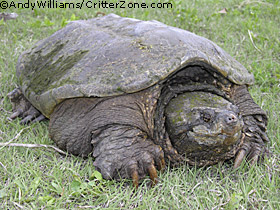 common snapping turtle, Chelydra serpentina
common snapping turtle, Chelydra serpentina
|
| With the exception of the soft-shelled turtles in the genus Trionyx, the snapping turtles are rather unique among turtles. They defend themselves in a manner similar to snakes by "striking" at the object of anger. The rapidity with which the head is lurched forward rivals the dexterity of the rattlesnake. So quick is the movement that the eye is barely able to follow it. Backed up by a pair of sharp-edged, cutting mandibles and jaw muscles of tremendous power, the strike of these dangerous brutes may be followed by a serious injury. The amputation of a finger by a medium-sized specimen, or a hand by a large adult, would be an accomplishment of no difficulty. |
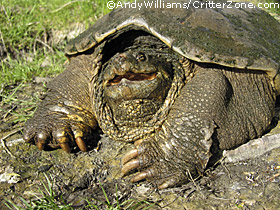 snapping turtle hissing and biting
snapping turtle hissing and biting
|
| These turtles typically lie partially embedded in the mud of the river bottom. In this pose, the rapid movements of the head and neck are important for the capture of fish which form the majority of their food. The snapping turtle is an exceedingly voracious brute, and is not particular as to its dinner. Young waterfowl are stalked from beneath the surface, seized by a dart of the jaws and pulled below to drown and be quickly torn to pieces. The turtle is carnivorous. It never feeds unless underwater, but it will sometimes seize prey on the bank of a stream and then retreat to the water to dine. |
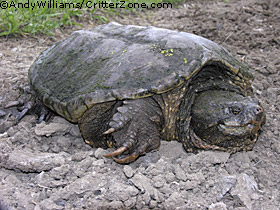 common snapping turtle, Chelydra serpentina
common snapping turtle, Chelydra serpentina
|
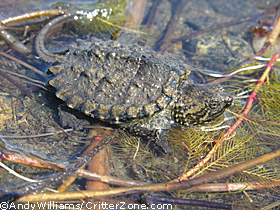 baby snapping turtle, Chelydra serpentina
baby snapping turtle, Chelydra serpentina
|
| As a captive the snapping turtle feeds readily and lives for many years. It will take food from the hand that feeds it, but most specimens snap viciously when handled. Though there aren't a lot of good reasons to do this, the safest way to handle a large snapper is to pick it up by the tail and hold it far away from one's body. They can be saved from certain death in rural roadways in this manner. Despite your good intentions, the Snapping Turtle may not appreciate being handled, and can manuever it's head far over it's back. They can also strike a considerable distance sideways. It is dangerous to hold a large specimen by the shell. Small snappers may be safely handled by grasping them by the rear portion of the shell which removes fingers from the immediate vicinity of jaws. |
| In the early summer, the female leaves her watery home and prowls around for a place to deposit her eggs. She often wanders many feet from the water. After selecting a damp spot, she scoops away the dirt to form a hole into which she crawls and moves about until the loose soil falls back over her. This way she's hidden until up to two dozen eggs are deposited. As she crawls out of the nest, the dirt that fell on top of her shell slides off and is left covering the eggs. The eggs are perfectly round, white and have a thin, hard shell. |
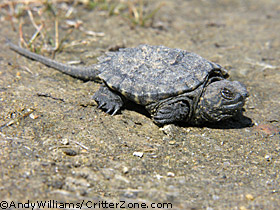 baby snapping turtle, Chelydra serpentina
baby snapping turtle, Chelydra serpentina
|
| Being aquatic the shells of many snapping turtles become coated with moss. The turtle may look much like a flat stone as it partially buries itself in the muddy bottom of shallow water. Here they remain for hours, poking the extreme tip of the snout from the water to breathe. They're able to remain for long periods entirely submerged and will dive to the deepest portions of rivers where they prowl along the bottom in search of food. |
The snapping turtle is a unique and fascinating native American species. Next time you're out by your local lake or pond, keep your eyes peeled for a snout poking up from the depths below.
Andy Williams / CritterZone.com |
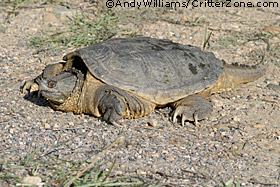 snapping turtle, Chelydra serpentina
snapping turtle, Chelydra serpentina
|
The snapping turtle photos on this page are available for commercial stock photography license. All photos and text that appears on this webpage is copyrighted and may not be copied or used in any way without permission from CritterZone. You can view more snapping turtle photos in our online gallery:
snapping turtle, Chelydra serpentina, stock photos
CritterZone does not specifically endorse our advertisers, or their methods. We cannot control the ads that run on our articles. CritterZone advocates humane and respectful treatment of all creatures. |
Save this page:

|